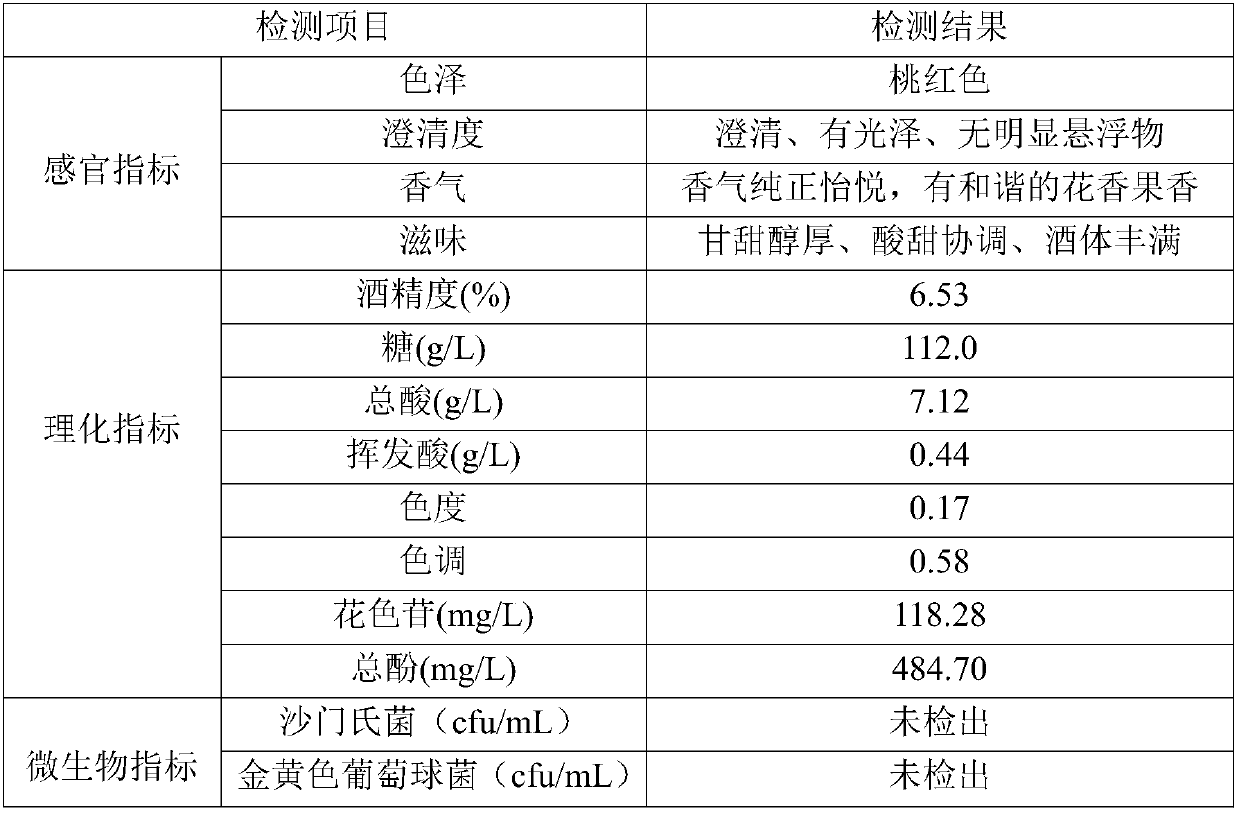Sweet low-alcohol pink wine brewing method
A technology for mellow pink wine and red grapes, which is applied in the preparation of wine, the method based on microorganisms, and the preparation of alcoholic beverages, etc. It can solve the problems of not being suitable for industrial production, lack of aroma, and high acidity, and achieve lower alcohol content, sweetness and refreshing The effect of simple taste and process
- Summary
- Abstract
- Description
- Claims
- Application Information
AI Technical Summary
Problems solved by technology
Method used
Image
Examples
Embodiment 1
[0022] Embodiment 1: the brewing method of the sweet type low-alcohol rosé wine of the present embodiment, comprises the following steps:
[0023] (1) Dissolve non-Saccharomyces cerevisiae Metschnikowia pulcherrima in 20 times the volume of distilled water, first activate it in a constant temperature water bath at 33°C for 15 minutes; then add an equal volume of red grape juice, activate it in a constant temperature water bath at 28°C for 15 minutes, and obtain non-Saccharomyces cerevisiae activation solution .
[0024] (2) After sorting, destemming, and crushing, the red grapes after picking are put into the fermenter with skin residue, and 40 mg / L of SO is added according to its mass. 2 and 20mg / L of pectinase, macerated at 4°C for 48h, and filtered to remove the pomace to obtain red grape juice.
[0025] (3) Add the non-Saccharomyces cerevisiae activation liquid at 0.10 g / L to the raw juice, leave it to ferment at a constant temperature at 23° C., shake the bottle three ti...
Embodiment 2
[0031] Embodiment 2: the brewing method of the sweet type low-alcohol rosé wine of the present embodiment, comprises the following steps:
[0032] (1) Dissolve non-Saccharomyces cerevisiae Metschnikowia pulcherrima in 10 times the volume of distilled water, first activate it in a constant temperature water bath at 28°C for 5 minutes; then add an equal volume of red grape juice, activate it in a constant temperature water bath at 20°C for 5 minutes, and obtain non-Saccharomyces cerevisiae activation solution .
[0033] (2) After sorting, destemming, and crushing, the red grapes after picking are put into the fermenter with skin residue, and 40 mg / L of SO is added according to its mass. 2 and 20mg / L of pectinase, macerated at 0°C for 24 hours, and filtered to remove the pomace to obtain red grape juice.
[0034] (3) Add the non-Saccharomyces cerevisiae activation liquid at 0.25 g / L to the raw juice, leave it to ferment at a constant temperature at 23° C., shake the bottle three...
Embodiment 3
[0040] Embodiment 3: the brewing method of the sweet type low-alcohol rosé wine of the present embodiment, comprises the following steps:
[0041] (1) Dissolve the non-Saccharomyces cerevisiae Metschnikowia pulcherrima in 15 times the volume of distilled water, and activate it in a constant temperature water bath at 30°C for 10 minutes; then add an equal volume of red grape juice and activate it in a constant temperature water bath at 25°C for 10 minutes to obtain a non-Saccharomyces cerevisiae activation solution .
[0042] (2) After sorting, destemming, and crushing, the red grapes after picking are put into the fermenter with skin residue, and 40 mg / L of SO is added according to its mass. 2 and 20mg / L of pectinase, macerated at 2°C for 36h, and filtered to remove the pomace to obtain red grape juice.
[0043](3) Add the non-Saccharomyces cerevisiae activation liquid at 0.2 g / L to the raw juice, leave it to ferment at a constant temperature at 25° C., shake the bottle three...
PUM
 Login to View More
Login to View More Abstract
Description
Claims
Application Information
 Login to View More
Login to View More - Generate Ideas
- Intellectual Property
- Life Sciences
- Materials
- Tech Scout
- Unparalleled Data Quality
- Higher Quality Content
- 60% Fewer Hallucinations
Browse by: Latest US Patents, China's latest patents, Technical Efficacy Thesaurus, Application Domain, Technology Topic, Popular Technical Reports.
© 2025 PatSnap. All rights reserved.Legal|Privacy policy|Modern Slavery Act Transparency Statement|Sitemap|About US| Contact US: help@patsnap.com

